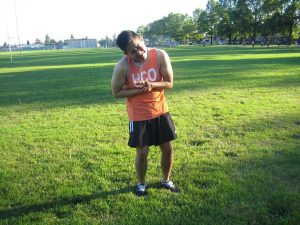The flexor pollicis longus is a muscle in the forearm and hand that function in flexing the thumb. This muscle is unique to humans and absent in other primates. Injuries to the tendons of the flexor pollicis longus takes several days to heal due to insufficient supply of blood to the tendons.
What are the indications of flexor pollicis longus pain?
- Discomfort and aching sensation can be felt at the tip of the thumb
- Thumb pain
- Pain and difficulty in buttoning buttons
- Pain and discomfort when holding a pencil
- Locking and popping sound can be heard at the joints of the thumb
- Difficulty and pain when gripping or grasping objects

Discomfort and aching sensation can be felt at the tip of the thumb.
Causes
- Continuous and prolonged gripping of tools
- Long periods of painting
- Repetitive writing
- Repetitive counting of paper bills
- Gardening and pulling out weeds using the thumb and fingers
Treatment
- Massage the affected area or another alternative is using supports or braces. Massage the area using cold therapy or heat to relieve the pain. Wear support and braces for the wrist and thumb to reduce pain due to flexor pollicis longus. Another alternative is wearing a splint for the finger. Avoid wraping it too tight to prevent issues with circulation. Loosen the splint if there is tingling, numbness or bluish discoloration. Maintain cleanlines of the splint or brace.
- Apply an ice pack on the affected area for at least 20 minutes at 2-3 times every day to lessen the stiffness, swelling and pain. Avoid placing the pack directly on the skin to prevent further damage and worsen the condition.
- Move the fingers frequently to avoid stiffness and lessen the swelling.
- Elevate the affected area above the level of the heart while sitting or lying down. Raise the area using a couple of pillows to prevent accumulation of fluids or inflammation.
- Utilize an ice wrap on the wrist to provide compression of the entire muscle and for fast healing of the condition. Start wearing the wrap for at least 20 minutes and gradually increase the length. The wrap can be adjusted so that it covers the thumb.
- Apply heat on the affected area to lessen the pain, inflammation and stiffness for at least 3-4 times every day.
- Wear arm compression sleeves to relieve discomfort and pain at the flexor pollicis longus muscle. It provides supports to the muscles and prevents further injury and promotes fast recovery from the condition.
Disclaimer / More Information
The material posted on this page on flexor pollicis longus pain is for learning purposes only. Learn to recognize and manage muscle injuries and conditions by taking a first aid and CPR class with one of our training providers.
FACT CHECK
https://en.wikipedia.org/wiki/Flexor_pollicis_longus_muscle
https://www.orthobullets.com/anatomy/10027/flexor-pollicis-longus
https://www.healthline.com/human-body-maps/flexor-pollicis-longus-muscle
